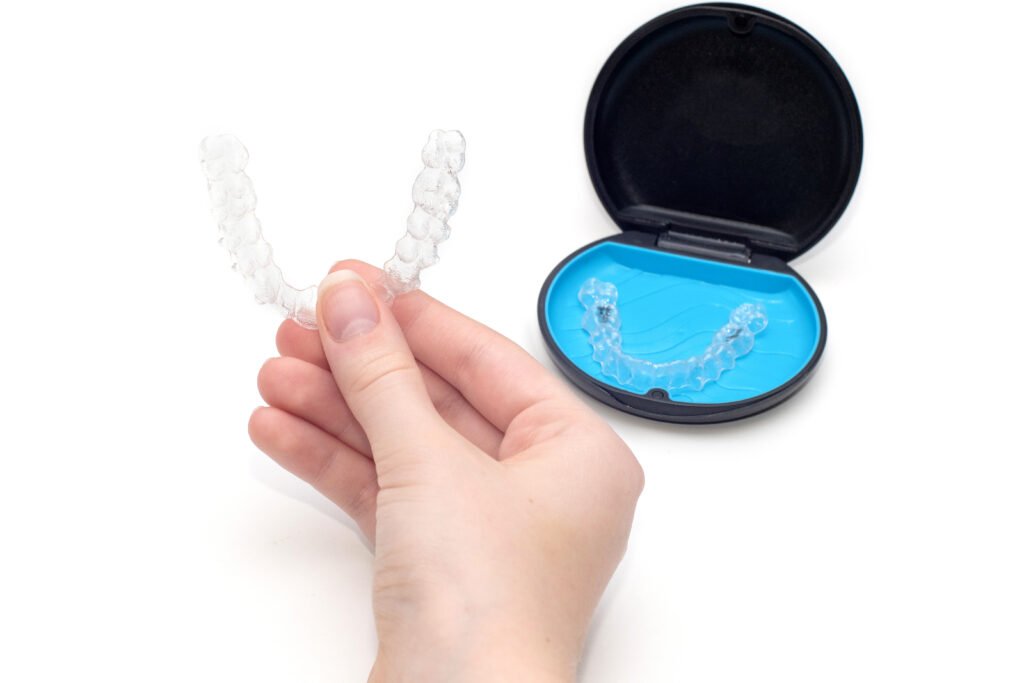What are Invisible Braces?
Invisible braces are revolutionary orthodontic devices that can straighten your teeth without the conspicuous metal brackets and wires of traditional braces. Made from transparent, medical-grade plastics, these aligners are designed to fit snugly over your teeth and are virtually invisible. While Invisalign is the most well-known brand, there are numerous other options like Orthoclear that also deliver excellent results.

How Do They Work?
The process begins with a customized treatment plan, which results in a series of removable aligners. These are replaced every 2-3 weeks to gradually shift your teeth into their ideal position. You can read more about my personal treatment experience here or in the video at the top.
Advantages vs. Traditional Braces
- Aesthetically Pleasing: One of the most obvious benefits is the appearance. Especially for adults, who may feel self-conscious with metal braces, invisible braces are a welcome alternative.
- More Comfortable: These braces are generally much more comfortable, thanks to the absence of metal parts that can irritate your mouth.
- Removable: You can take the braces out to eat, drink, and maintain oral hygiene, which is a significant advantage.
- Fewer Orthodontist Visits: The treatment plan is predetermined, reducing the number of necessary appointments.
- Food Freedom: No more worries about stuck food or damaged braces. Just remove and enjoy!
- Oral Health: Easier brushing and flossing mean a lower risk of tooth decay and discoloration.
- Active Lifestyle: Ideal for sports enthusiasts. You can remove them during any physical activity.

Disadvantages
However, invisible braces also have some drawbacks:
- Limited Correction Capabilities: They are usually not suitable for correcting severe orthodontic issues like severe overbites or complex tooth rotations.
- Higher Costs: This form of treatment can be significantly more expensive than traditional braces, which may be a key consideration if you’re on a budget.
- Required Discipline: For effective treatment, you need to wear the braces for about 20-22 hours a day. If you don’t wear them consistently, the treatment will not be as effective.
- Maintenance Required: You must remove the braces when you eat or drink (except water), and your teeth must be clean before putting them back in. This can be cumbersome if you’re frequently on the go.
- Regular Visits to the Orthodontist: You still need to regularly visit your orthodontist to monitor the treatment and progress, although these visits are less frequent than with metal braces.
- Risk of Loss or Damage: Because they are removable, there’s a risk that you could lose or damage them.
- Initial Discomfort: You may experience some discomfort, especially when you get a new set of aligners. This is usually temporary.
- Potential Speech Issues: Some people initially experience a slight speech impediment, although this typically improves quickly.
Are They Really Invisible?
Although the term “invisible braces” suggests they are entirely invisible, that’s not entirely true. These braces are made from a transparent plastic material, making them much less visible than traditional metal braces. From a distance or in photos, it’s unlikely that anyone will notice you’re wearing them. However, up close, people might be able to see that there’s something on your teeth.
Who Shouldn’t Use Invisible Braces?
- Complex Orthodontic Problems: Generally suitable for mild to moderate tooth adjustments, they are usually not the best option for complex orthodontic problems like severe overbites or underbites, multiple crossbites, and severe rotations or shifts of teeth.
- Young Children and Teens: Because they are removable, they require a degree of discipline and responsibility. For young children and some teens who have not yet developed this discipline, traditional braces are often a better choice.
- Chewing Issues: In cases where the teeth and jaw are severely misaligned, affecting chewing, traditional braces are often more effective in resolving these issues.
- Cost Factor: They are typically more expensive than traditional braces. People who are on a budget may consider traditional braces as a more cost-effective option.
- Oral Health: For people struggling with gum diseases, untreated tooth decay, or other severe oral health problems, it is crucial to address these first before undergoing any orthodontic treatment. Untreated oral health issues can hinder the success of the orthodontic treatment, regardless of the type of brace.

Conclusion
Invisible braces are an attractive and comfortable option for people with milder dental issues. However, they are not suitable for everyone, mainly due to higher costs, limitations for complex dental problems, and the level of discipline required to wear them. Always consult with a specialist to determine which type of brace is best for your situation.
Watch this video with my experience with invisible braces! (Spoken in Dutch language, English subtitles available)
DISCLAIMER:
This blog post about invisible braces is intended for informational purposes and should not be considered professional dental advice. Always consult a qualified dentist or orthodontist for advice and treatments tailored to your specific needs.



 Esthetisch arts: Dr. @kimdetollenaere
Esthetisch arts: Dr. @kimdetollenaere  Expert in gezichtsveroudering, gezichtscontouring, haarverlies & lipfillers
Expert in gezichtsveroudering, gezichtscontouring, haarverlies & lipfillers
 Questions?
Questions? WA: +32490128316
WA: +32490128316 Net dat tikkeltje meer v
Net dat tikkeltje meer v

 ) Injectables zijn allang niet meer
) Injectables zijn allang niet meer


 Asymmetrische wenkbrauwen
Asymmetrische wenkbrauwen 


 How to spot an unsafe aesthetic practitioner?
How to spot an unsafe aesthetic practitioner?
